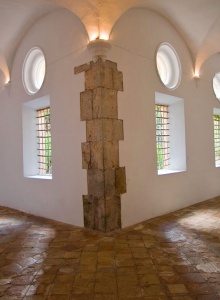The monumental compounds of Valldemossa rise between Sierra de Tramuntana and the Mediterranenan, a few kilometres away from the Majorcan Costa Nord.
The city's careful layout is filled with steep streets, stone façades and important religious buildings, among a luxuriant vegetation. The mountains of this area dive into the ocean, to form beaches and coves where it is possible to anchor any vessel. The port of Valldemossa preserves the fishing-town character of yore. Fresh fish and inland produce are wisely combined into succulent recipes that will delight visitors.
The village of Valldemossa is located a mere 17 kilometres away from Palma, in the middle of the valley of Sierra de Tramuntana, 400 kilometres above sea level. Part of the village goes up into the mountain slope, creating steep streets and beautiful natural miradors. The whole compound is surrounded by lush forests, with olive and almond trees that are irrigated by the abundant springs in the area.The green doors and windows of the houses contrast with the sober stone of which they are made. Green too are the tiles that cover the belltower of the Carthusian Monastery, perhaps the most emblematic monument of this town. This ancient monastery, which used to be the residence of Jaime II, housed Carthusian priests between 1399 and 1835. Its important historic legacy, as well as mementoes from two remarkable visitors: Frederic Chopin and George Sand, are preserved in cloisters, cells, gardens and museums. These mementoes include scores, pieces of writing, fittings and correspondence related to their stay in the island, in addition to the "Pleyel" piano. In memory of the outstanding polish composer, concerts are celebrated in the cloister and in the gardens of the Carthusian Monastery during the summer.The Municipal MuseumThe old pharmacy and the church are the most outstanding buildings in this religious compound, whose vaults exhibit frescoes by Miguel Bayeu, Goya's brother in law. The Municipal Museum is also part of this compound. An old press belonging to the Guasps and 1,450 xylographic plates are part of the museum's collection. Also worthy of note is the documentation compiled by Archduke Luis Salvador of Austria (19th-20th century) about the island and a gallery devoted to Sierra Tramuntana. There is a room devoted to contemporary art, with works by Miró, Picasso and Tápies, among other famous artists.In addition to the belltower of the Carthusian monastery, another tower rises above the rooftops in this Majorcan town: the parish church of San Bartolomé, from the 13th century. The gallery that crosses this church, however, was built much later.In Valldemossa, you can also visit the house where Santa Catalina Thomas was born, although her incorrupt body remains at the convent of the Augustinian Canons of Saint Magdalene of Palma. The old Carthusian monastery, palace of King Sancho, also exhibits a defensive tower, a cloister and a historic staircase. This old Royal residence was host, in its day, to such writers as Jovellanos, Ruben Darío, Unamuno and Azorín. The Port of ValldemossaOn the slope of the mountain where Valldemossa is located, a small hermitage awaits. From this small hermitic community, visitors can enjoy beautiful views of the village. Continue to the Port of Valldemossa to admire the Mediterranean Sea. A small fishing port speaks of an ancient nautical tradition. Pine woods and cliffs make up the coastal outline of the area, where coves and beaches are washed by pristine waters. Son Marroig, in Na Foradada point, is a great example. A paradise for those seeking peace and quiet in a natural environment.At Valldemossa, the traveller can enjoy the beautiful scenery of Sierra Tramuntana, or go to the nearby towns of Deià, Sóller, Banyalbufar, Santa Maria del Camí and Palma. Olive and almond trees grow among the ancient, Majorcan stone houses. The archaeological site of Deià spreads along the side of a small hill that overlooks the Mediterranean. On the other hand, Sóller has beautiful stately mansions and palatial residences among fields of orange trees. An ancient train will take you to the Port of Sóller, a perfect place to be delighted by Majorcan dishes, made with fresh fish and seafood.Rocks come all the way to the sea in places like Banyabufar, where visitors will be able to admire farmed terraces, typical of these mountainous, rough regions. Inland, you will find Santa Maria del Camí, founded in the first century B.C. by the Romans. It is famous for its crafts, especially forging, ceramics, embroidery, etc.Palma de Mallorcavisitors should also go to Palma. The capital of the Balearic Isles, famous for its beaches and beautiful sea, has a gorgeous historic quarter, deeply marked by history. The cathedral, the Palace of Almudaina, the fish market and Plaza Mayor are some of the places where visitors will have to stop. Fishing boats, pine groves and palm trees complement the most beautiful monuments. In any of these places you can enjoy Balearic cuisine, in close resemblance with Mediterranean cuisine. Products with their own Designation of Origin (the seal of quality and origin given in Spain to exceptional products from specific regions) such as "sobrasada" (a kind of spicy pork spread), cheese from Mahón and wines from Binissalem-Majorca, add to the flavour of the local dishes. Tumbet (a vegetable stew with potatoes, fried peppers and aubergine, covered with tomato sauce), rice-dishes with fish and "pa amb oli" (a piece of bread rubbed with oil and tomato) must not be missing form our table. Game meat, fish, seafood and fruit are part of the diverse gastronomy of the islands. For dessert, nothing better than "ensaimada" with some of the fine liqueurs distilled here, like "palo", gin and "hierbas"







